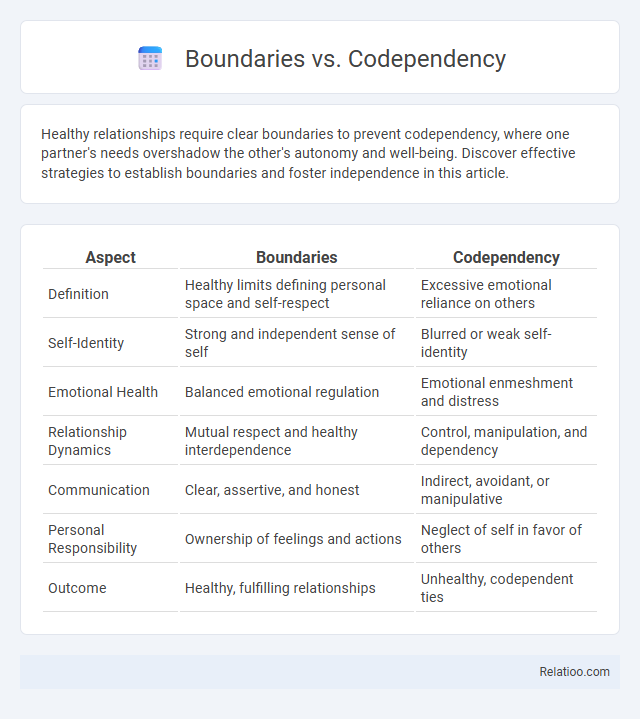Healthy relationships require clear boundaries to prevent codependency, where one partner's needs overshadow the other's autonomy and well-being. Discover effective strategies to establish boundaries and foster independence in this article.
Table of Comparison
| Aspect | Boundaries | Codependency |
|---|---|---|
| Definition | Healthy limits defining personal space and self-respect | Excessive emotional reliance on others |
| Self-Identity | Strong and independent sense of self | Blurred or weak self-identity |
| Emotional Health | Balanced emotional regulation | Emotional enmeshment and distress |
| Relationship Dynamics | Mutual respect and healthy interdependence | Control, manipulation, and dependency |
| Communication | Clear, assertive, and honest | Indirect, avoidant, or manipulative |
| Personal Responsibility | Ownership of feelings and actions | Neglect of self in favor of others |
| Outcome | Healthy, fulfilling relationships | Unhealthy, codependent ties |
Understanding Boundaries: Definition and Importance
Boundaries are personal limits that define acceptable behavior and protect emotional well-being, essential for maintaining healthy relationships and self-respect. Understanding boundaries helps differentiate them from codependency, where individuals lose their sense of self by excessively prioritizing others' needs over their own. Clear boundaries prevent codependent patterns by promoting autonomy, mutual respect, and balanced emotional interdependence.
What is Codependency? Signs and Symptoms
Codependency is a behavioral condition where You prioritize others' needs over Your own, often sacrificing personal boundaries to gain approval or control. Common signs and symptoms include low self-esteem, excessive people-pleasing, difficulty saying no, and an overwhelming need to fix or rescue others. Recognizing these patterns is crucial to differentiate codependency from healthy boundaries, which involve mutual respect and self-care.
Key Differences Between Boundaries and Codependency
Boundaries are healthy limits people set to protect their emotional and physical well-being, promoting self-respect and autonomy, whereas codependency involves excessive emotional reliance on others, often leading to enabling behaviors and loss of self-identity. Key differences include that boundaries emphasize mutual respect and personal accountability, while codependency fosters enmeshment and imbalance in relationships. Understanding these distinctions helps identify when relationships shift from supportive to unhealthy patterns requiring intervention.
The Psychology Behind Healthy Boundaries
Healthy boundaries are essential for maintaining your mental well-being by clearly defining limits between your emotions and others' feelings, preventing codependency. Psychological research highlights that strong boundaries foster self-respect and autonomy, empowering you to manage relationships without compromising your identity. Understanding the difference between boundaries and codependency helps you cultivate emotional resilience and promote healthier interpersonal dynamics.
How Codependency Develops in Relationships
Codependency develops in relationships when individuals prioritize others' needs over their own, often due to enmeshed boundaries and a deep-seated fear of abandonment or rejection. Weak personal boundaries allow one partner to sacrifice self-care and autonomy, fostering a dynamic where approval and validation become essential for self-worth. Over time, this leads to an unhealthy reliance on the other person, perpetuating a cycle of dependency and emotional imbalance.
Impact of Poor Boundaries on Mental Health
Poor boundaries often lead to codependency, where an individual's sense of self becomes overly reliant on others' approval, resulting in heightened anxiety and depression. Your inability to establish clear personal limits can cause emotional exhaustion, increased stress, and a diminished sense of autonomy. Effective boundary setting is crucial to maintaining mental health and preventing the destructive patterns associated with codependency.
Steps to Establish Healthy Boundaries
Establishing healthy boundaries involves recognizing your personal limits and communicating them clearly to others to prevent codependency, which often arises from blurred or nonexistent boundaries. Begin by identifying your emotional and physical needs, then assertively express these without guilt or apology to maintain your well-being and autonomy. Your commitment to consistent boundary-setting reduces codependent patterns, fostering healthier, more balanced relationships.
Overcoming Codependent Behaviors
Setting clear boundaries is essential for overcoming codependent behaviors, as it helps you maintain your emotional autonomy and prevents others from controlling your feelings. Recognizing patterns of codependency, such as excessive people-pleasing or difficulty saying no, allows you to develop healthier relationships based on mutual respect. Implementing strategies like assertive communication and self-care empowers you to break free from codependent cycles and build a stronger sense of self.
Practical Tips for Maintaining Boundaries
Maintaining healthy boundaries is essential to prevent slipping into codependency, where your sense of self may become enmeshed with another's needs. Practical tips include clearly communicating your limits, practicing self-care, and recognizing when you are overextending emotionally to avoid losing your autonomy. Strengthening Your boundaries empowers you to foster balanced relationships without sacrificing your well-being.
Transforming Relationships: From Codependency to Empowerment
Setting clear boundaries is essential for transforming relationships from codependency to empowerment, promoting healthier emotional dynamics and mutual respect. Codependency often involves excessive reliance on others for validation and a blurred sense of self, which boundaries help to define and protect. Embracing empowerment requires recognizing personal needs, fostering independence, and cultivating balanced interdependence within relationships.

Infographic: Boundaries vs Codependency
 relatioo.com
relatioo.com